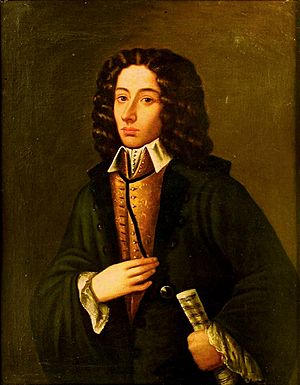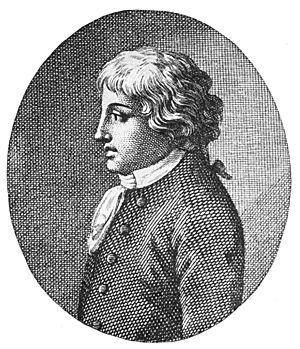Giovanni Battista Pergolesi facts for kids
Giovanni Battista Pergolesi (born January 4, 1710 – died March 16 or 17, 1736) was a famous Italian Baroque composer. He also played the violin and organ. Pergolesi is best known for his beautiful sacred music, like the Stabat Mater. He also wrote popular operas, including the comic opera La serva padrona (which means The Maid Turned Mistress). Sadly, he died very young, at just 26 years old, from tuberculosis.
Contents
Pergolesi's Life Story
Giovanni Battista Pergolesi was born in Jesi, a town in what is now Italy. His family came from a town called Pergola, which is why he was often called "Pergolesi."
He started learning music in Jesi with a local musician named Francesco Santi. Later, in 1725, he moved to Naples to continue his studies. There, he learned from well-known teachers like Gaetano Greco.
After finishing his studies in 1731, Pergolesi started to become famous. He wrote an oratorio (a large musical work for voices and orchestra) called La fenice sul rogo, o vero La morte di San Giuseppe. He also composed a sacred play, The Miracles of Divine Grace in the Conversion and Death of Saint William.
Most of Pergolesi's short life was spent working for wealthy families. These included important people like Ferdinando Colonna, the Prince of Stigliano.
The Birth of Comic Opera
Pergolesi was one of the first important composers of opera buffa, which means "comic opera." These operas were light-hearted and funny.
His serious opera, Il prigionier superbo, included a short, funny interlude called La serva padrona (The Servant Mistress). This short comic opera became incredibly popular on its own!
When La serva padrona was performed in Paris in 1752, it caused a big argument. This argument was called the Querelle des Bouffons, or "quarrel of the comic actors." People in Paris were divided. Some loved the serious French operas of composers like Jean-Baptiste Lully. Others preferred the new, lively Italian comic operas. Pergolesi's music was seen as a perfect example of this exciting new Italian style. This argument lasted for two years and really shook up the music world in Paris.
Pergolesi wrote several other operas. His first opera was La Salustia (1732). He also wrote Lo frate 'nnamorato (The brother in love, 1732) and Il Flaminio (1735), both in the local Neapolitan language. His opera L'Olimpiade (1735) was first performed in Rome. All his other operas premiered in Naples.
His Sacred Music and Legacy
Pergolesi also composed beautiful sacred music (music for religious services). This included a Mass in F and three Salve Regina settings.
His most famous sacred work is the Stabat Mater (1736). This piece is for a soprano singer, an alto singer, string orchestra, and basso continuo. It was written for a group that held an annual Good Friday service. Pergolesi's Stabat Mater replaced an older version by Alessandro Scarlatti. This shows how quickly musical tastes were changing back then!
The Stabat Mater became one of the most printed musical works of the 18th century. Other composers, like Johann Sebastian Bach, even adapted it. Bach used Pergolesi's music for his own cantata called Tilge, Höchster, meine Sünden.
Pergolesi also wrote instrumental music, like a violin sonata and a violin concerto. However, many pieces once thought to be by Pergolesi were later found to be by other composers. For example, much of Igor Stravinsky's ballet Pulcinella, which was supposed to use Pergolesi's music, actually used works by composers like Domenico Gallo. Also, the Concerti Armonici were written by Unico Wilhelm van Wassenaer.
Giovanni Battista Pergolesi died on March 16 or 17, 1736, in Pozzuoli. He was only 26 years old. He was buried at a Franciscan monastery the next day.
In 1932, an Italian film about his life, called Pergolesi, was made.
Pergolesi's Music in Movies
Pergolesi's music has been used in many films:
- His Salve Regina is featured in the movie Farinelli (1994).
- Parts of his Stabat Mater were used in the soundtrack of Jesus of Montreal (1989).
- The fifth part of Stabat Mater ("Quis est homo") was in Smilla's Sense of Snow (1997).
- The last part of Stabat Mater was used in the famous movie Amadeus (1984) and in The Mirror (1975).
- The Australian film Cactus (1986) also features Pergolesi's Stabat Mater.
- The 2016 documentary Nothing Left Unsaid used the final movement of Stabat Mater.
Pergolesi's Works
A standard list of Pergolesi's works was created by Marvin Paymner in 1977. Each piece has a unique "P" number. For example, the famous Stabat Mater is P.77.
Sacred Music
- Antifona “In caelestibus regnis” (1731)
- Confitebor tibi Domine (Psalm 111) in C (1732)
- Dixit Dominus (Psalm 110) (1732)
- Laudate pueri Dominum (Psalm 113) in D (1734)
- Mass in D (1732)
- Mass in F “San Emidio” (1732)
- Oratorio La fenice sul rogo, o vero La morte di San Giuseppe (1731)
- Dramma sacro Li prodigi della divina grazia nella conversione e morte di san Guglielmo duca d'Aquitania (1731)
- Salve regina in a (1731)
- Salve regina in c (1735)
- Salve regina in f (1736)
- Stabat Mater in f (written 1735, performed 1736)
Operas
- La Salustia (January 1732, Naples)
- Lo frate 'nnamorato (September 27, 1732, Naples)
- Il prigionier superbo, with the intermezzo La serva padrona (August 28, 1733, Naples)
- Adriano in Siria, with the intermezzo Livietta e Tracollo (October 25, 1734, Naples)
- L'Olimpiade (January 1735, Rome)
- Il Flaminio (autumn 1735, Naples)
Orchestral Music
- Sinfonia in B-flat major
- Sinfonia in D major
- Sinfonia in F major
- Sinfonia in G major, P.35
- Sinfonia in G minor, P.24c
- Flute Concerto in G major, P.33 (likely not by Pergolesi)
- Concerto for Flute and 2 Violins in D major
- Concerto for Flute and 2 Violins in G major
- Concerto for 2 Harpsichords and Orchestra
- Violin Concerto in B flat major
Keyboard Works
- Harpsichord Sonata in A major, P.1
- Harpsichord Sonata in D major
- Organ Sonata in F major
- Organ Sonata in G major
Chamber Works
- Trio Sonata in G major, P.12
- Trio Sonata in G minor
- Unspecified Andantino, for violin and piano
- Violin Sonata in G major
- Sonata No.1 in G major, for 2 violins
- Sinfonia in F major, for cello and continuo
See also
 In Spanish: Giovanni Battista Pergolesi para niños
In Spanish: Giovanni Battista Pergolesi para niños



